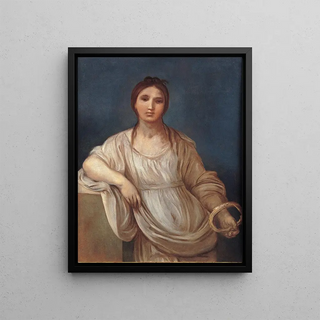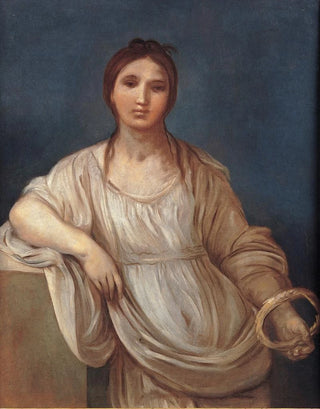Art print | Portrait of a girl with a crown - Guido Reni


View from behind

Frame (optional)
In the fascinating world of baroque art, the "Portrait of a girl with a crown" by Guido Reni stands out for its elegance and delicacy. This artwork, which evokes timeless beauty, invites the viewer to immerse themselves in a universe where grace and serenity meet. The depiction of a young girl adorned with a crown symbolizes not only childhood purity but also majesty and nobility. Through this painting, Reni succeeds in capturing innocence and splendor, revealing an emotional depth that transcends time. Every gaze upon this piece is an invitation to explore the subtleties of the human soul, while marveling at the artist's technical virtuosity.
Style and uniqueness of the work
Guido Reni's style is characterized by an exceptional mastery of light and shadow, which gives an almost divine dimension to his subjects. In the "Portrait of a girl with a crown," the radiant brightness of pastel tones harmonizes with the softness of the child's features, creating an atmosphere filled with tenderness. The composition is carefully balanced, with each element arranged to guide the viewer's eye toward the radiant face of the young girl. The meticulous details, such as the texture of the clothing and the delicacy of the hair, demonstrate a concern for realism that is typical of baroque art. This painting is not merely a simple representation; it also evokes a narrative, a story hidden behind the child's innocent gaze. Through this work, Reni manages to establish a dialogue between the viewer and the subject, making the contemplative experience all the more enriching.
The artist and his influence
Guido Reni, born in Bologna in 1575, is one of the masters of Italian baroque, recognized for his unique style that combines impeccable technique with emotional sensitivity. Trained in the workshop of the Bologna school, he established himself as a major artist of his time, influencing many contemporaries and future generations. Reni was able to interpret classical themes with unmatched finesse, blending mythology, religion, and

Matte finish

View from behind

Frame (optional)
In the fascinating world of baroque art, the "Portrait of a girl with a crown" by Guido Reni stands out for its elegance and delicacy. This artwork, which evokes timeless beauty, invites the viewer to immerse themselves in a universe where grace and serenity meet. The depiction of a young girl adorned with a crown symbolizes not only childhood purity but also majesty and nobility. Through this painting, Reni succeeds in capturing innocence and splendor, revealing an emotional depth that transcends time. Every gaze upon this piece is an invitation to explore the subtleties of the human soul, while marveling at the artist's technical virtuosity.
Style and uniqueness of the work
Guido Reni's style is characterized by an exceptional mastery of light and shadow, which gives an almost divine dimension to his subjects. In the "Portrait of a girl with a crown," the radiant brightness of pastel tones harmonizes with the softness of the child's features, creating an atmosphere filled with tenderness. The composition is carefully balanced, with each element arranged to guide the viewer's eye toward the radiant face of the young girl. The meticulous details, such as the texture of the clothing and the delicacy of the hair, demonstrate a concern for realism that is typical of baroque art. This painting is not merely a simple representation; it also evokes a narrative, a story hidden behind the child's innocent gaze. Through this work, Reni manages to establish a dialogue between the viewer and the subject, making the contemplative experience all the more enriching.
The artist and his influence
Guido Reni, born in Bologna in 1575, is one of the masters of Italian baroque, recognized for his unique style that combines impeccable technique with emotional sensitivity. Trained in the workshop of the Bologna school, he established himself as a major artist of his time, influencing many contemporaries and future generations. Reni was able to interpret classical themes with unmatched finesse, blending mythology, religion, and






